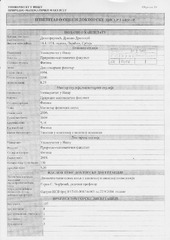Приказ основних података о дисертацији
Dinamika tahionskih polja u klasičnoj kvantnoj kosmologiji
| dc.contributor.advisor | Đorđević, Goran | |
| dc.contributor.other | Nešić, Ljubiša | |
| dc.contributor.other | Dugić, Miodrag | |
| dc.creator | Dimitrijević, Dragoljub D. | |
| dc.date.accessioned | 2017-09-11T08:09:22Z | |
| dc.date.available | 2017-09-11T08:09:22Z | |
| dc.date.available | 2020-07-03T16:12:27Z | |
| dc.date.issued | 2015-09-30 | |
| dc.identifier.uri | https://nardus.mpn.gov.rs/handle/123456789/8531 | |
| dc.identifier.uri | http://eteze.ni.ac.rs/application/showtheses?thesesId=5230 | |
| dc.identifier.uri | https://fedorani.ni.ac.rs/fedora/get/o:1393/bdef:Content/download | |
| dc.identifier.uri | http://vbs.rs/scripts/cobiss?command=DISPLAY&base=70052&RID=1025089513 | |
| dc.description.abstract | In this PhD thesis classical and quantum dynamics of tachyon systems are examined. Those systems are described by spatially homogeneous scalar fields, in the limit of classical and quantum mechanics and cosmological applications. Understanding and modeling of these systems are of particular importance in the development of the field and string theory. In this thesis its application in the modern cosmology, inflationary, classical and quantum phase in the evolution of the Universe will be discussed. The main part of the thesis is devoted to study of the dynamics of scalar tachyonic field with non-standard Lagrangian of DBI type, or Lagrangian used in so-called effective field theories, with various potentials. The interest for this research originates from Sen's assumptions about the essential role of tachyonic fields in fundamental interactions of brains, or string theory and their direct implications on the pre-classical phase of cosmic inflation. It is suitable to use lower-dimensional models, including zero-dimensional classical-mechanical analogue, to better understand the dynamics of tachyon systems and their modeling. In this thesis original calculations for several specific and important tachyon potentials are presented in detail. Those potentials are also exactly solvable in the framework of Friedmann cosmology, and they have their great physical motivation in the current system of string theory and inflationary cosmology. The procedure of transition to lower-dimensional theory is the standard one in field theory. Systems with an infinite number of degrees of freedom in the limits of classical mechanics transit to the systems with fini te number of degrees of freedom. The equations of motion, their solutions, applications of solutions in calculation of the classical Lagrangians and actions are essential elements of this part of the thesis. 8 Besides, the locally equivalent Lagrangians of the standard type are considered. Those Lagrangians lead to the same equations of motion as well as initial (DBI) tachyonic Lagrangian. Two methods of finding a standard Lagrangian are shown. In the first method, one starts from the equations of motion and the standard Lagrangian is constructed by standard procedure. In this procedure the field has to be rescaled in appropriate way. The second method is based on the classical canonical transformations. In this method it is not necessary to rescale the field. For a certain class of tachyon potentials, by the correct choice of generating function of canonical transformation, the standard Lagrangian and quadratic actions can be found. In addition, it was shown that additional degrees of freedom can be introduced in the theory, by which observed phase space expands, and the system can now be equivalently described by the Lagrangian of a standard form, with the identical classic action of initial and “new” Lagrangian. A part of the thesis is devoted to the consideration of the previous systems and the models not only on real, but also on nonarcimedian and ultrametric spaces. The physical processes under consideration, the formation of the Universe and the beginning of the inflationary phase, essentially are related to the quantum effects and the Planck scale, where the standard - Archimedean geometry and real numbers , and their algebraic extension - complex numbers , are inadequate or, at least, incomplete. One of the most promising alternatives is to use nonarchimedean geometry and the fields of p-adic numbers p . The considered models are based on several tachionic potentials on Archimedean and nonarchimedean geometries, and fields of numbers and p on adelic approach. The procedure of quantization of tachyon system in real, p-adic and adelic case in the framework of the Feynman path integral is shown. The possible application of the results obtained to describe the period of cosmological inflation using the tachyon fields are discussed in the final part. Besides, open problems in the respective quantum cosmological models - the wave function of the universe, and classic models, with Minkowski metric, especially with FRW metric, are discussed. | en |
| dc.format | application/pdf | |
| dc.language | sr | |
| dc.publisher | Универзитет у Нишу, Природно-математички факултет | sr |
| dc.rights | openAccess | en |
| dc.rights.uri | https://creativecommons.org/licenses/by-nc-nd/4.0/ | |
| dc.source | Универзитет у Нишу | sr |
| dc.subject | kosmologija | sr |
| dc.subject | Cosmology | en |
| dc.subject | p-adic numbers | en |
| dc.subject | tachyonic inflation | en |
| dc.subject | r-adični brojevi | sr |
| dc.subject | tahionska inflacija | sr |
| dc.title | Dinamika tahionskih polja u klasičnoj kvantnoj kosmologiji | sr |
| dc.type | doctoralThesis | en |
| dc.rights.license | BY-NC-ND | |
| dcterms.abstract | Ђорђевић, Горан; Дугић, Миодраг; Нешић, Љубиша; Димитријевић, Драгољуб Д.; Динамика тахионских поља у класичној квантној космологији; Динамика тахионских поља у класичној квантној космологији; | |
| dc.identifier.fulltext | http://nardus.mpn.gov.rs/bitstream/id/54384/Dimitrijevic_Dragoljub_D.pdf | |
| dc.identifier.fulltext | http://nardus.mpn.gov.rs/bitstream/id/54383/Disertacija.pdf | |
| dc.identifier.fulltext | https://nardus.mpn.gov.rs/bitstream/id/54383/Disertacija.pdf | |
| dc.identifier.fulltext | https://nardus.mpn.gov.rs/bitstream/id/54384/Dimitrijevic_Dragoljub_D.pdf | |
| dc.identifier.rcub | https://hdl.handle.net/21.15107/rcub_nardus_8531 |



